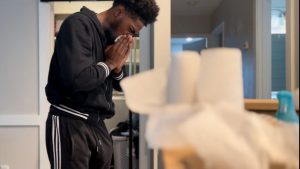Zariah Balentine
Staff Writer
On Aug. 24, 2019, Hurricane Dorian made its way through the southeastern U.S. coast striking the northern part of the Bahamas, leaving 70,000 people homeless and killing at least 45 people.

During the two weeks of tracking through the Atlantic coastline, the strength of the tropical storm increased and swept across the southeastern coast into a powerful tropical hurricane.
According to Weather.com, sustained winds were 82 mph with gusts to 111 mph.
By the time the tropical storm warning was first issued in northwestern Bahamas, Dorian became stronger and intensified to a Category 4 before growing into its most powerful
Dorian slowly grew into a historically powerful Category 5 system reaching sustained wind speeds of 185 mph— making it the first destructive natural disaster since 1935 on Labor Day.
The Bahamas was not the only land affected. Coastal communities from South Florida through the Carolinas also prepared for the hurricane’s entrance into the region.
As a result of the weather getting worse, mandatory evacuations were called to order in over a dozen counties across three states—Florida being the highest number of impacts.
From airport closures to evacuations to power outages, Hurricane Dorian caused devastation to all communities. Streets overflowing, homes ripped apart from the gusty winds and damages, and people without a place to live was a reality for thousands of U.S citizens.
Selicia Basden, a freshman business administration major from Nassau, Bahamas, is shocked by the damage Hurricane Dorian from his hometown.
“The hurricane’s strength was one I have never experienced, so for me, it was mind-blowing and disheartening to know my country was falling apart,” said Basden.
Basen also mentioned how Dorian affected her family and friends.
“It breaks my heart to know that it destroyed many people’s homes, separated families, and caused fatalities. This natural disaster is the worst to ever hit the Bahamas.”
Another tropic island that succumbed to the weather storm was U.S. Virgin Islands. Known for its breathtaking scenery, as Dorian entered the U.S. territory, individuals witnessed a dark and grimy atmosphere.
It became so extreme, President Donald Trump issued a state of emergency and ordered federal assistance for Virgin Islanders.
Dorian Hairston, a sophomore political science major from St. Thomas, U. S. Virgin Islands said that though residing on an island, the risks of living near water during hurricane season is increasingly dangerous.
“That’s the price we pay for living in paradise because the storms come off the coast of Africa and then they come through the Caribbean before it reaches Florida or the Gulf of Mexico,” said Hairston.
Hairston also explained the formation of tropical storms in the Atlantic—citing what most geographers state are tropical cyclones.
“It may make its way to South America, however, usually hurricanes cross through the Caribbean island because that is where the water is hot. Hurricanes like hot water so they form where there is heat.”
“The waters have been circulating a lot of moisture and heat lately, so that means it gave the hurricane a lot more time to build and grow into a destructive natural disaster,” Hairston stated.




Be First to Comment